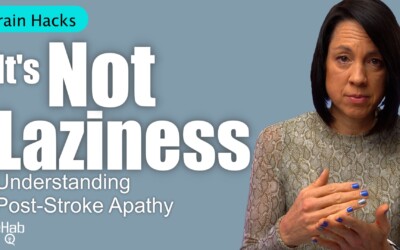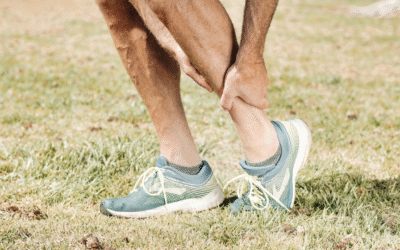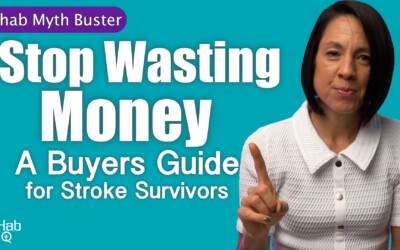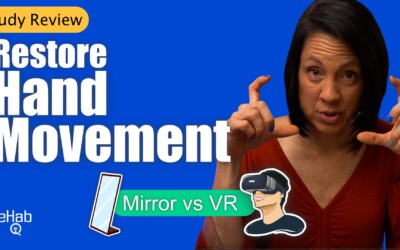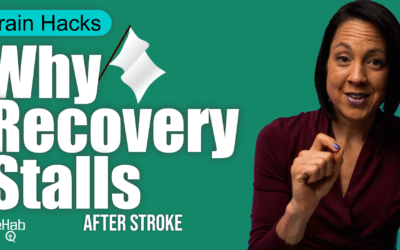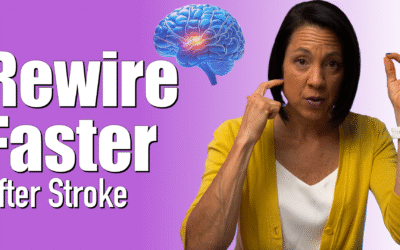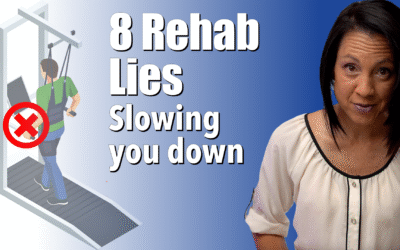HIIT for Stroke Recovery
Boost brain rewiring, improve movement, and speed recovery with short bursts of exercise.
If you’ve been on your stroke recovery journey for a while, you’ve probably heard the word neuroplasticity. Neuroplasticity is how your brain forms new connections so you can relearn skills like walking, talking, and using your hands again.
Important facts about neuroplasticity:
- It happens throughout your life, not just in the first 18 months after injury.
- Everyone with a neurological injury has the potential to improve.
- Progress isn’t just about repetition, the brain needs the right environment to rewire effectively.
What Happens in Your Brain During a Stroke?
A stroke happens when blood flow to part of your brain is blocked, or when a blood vessel in your brain bursts. This causes a sudden chaotic event inside your brain:
- Some brain cells (neurons) get damaged or die because they aren’t getting enough oxygen and nutrients.
- Other neurons around the damaged area go offline or stop working properly.
- The whole area becomes unstable and disorganized for a while.
This chaos actually primes your brain for neuroplasticity, meaning it becomes ready to rewire itself and make new connections to take over lost functions. That’s why getting into rehab as soon as possible is so important because it helps your brain take advantage of this window to start healing.
The Brain Chemicals That Make Neuroplasticity Possible
Three main “signaling molecules” help your brain form new connections:
- BDNF (Brain-Derived Neurotrophic Factor) – Supports neuron growth and survival.
- VEGF (Vascular Endothelial Growth Factor) – Promotes new blood vessel growth in the brain.
- Lactate – Acts as a backup fuel source for brain energy.
Why they matter:
- People with lower levels of these molecules have a higher risk of stroke, heart disease, and diabetes.
- After a stroke, these levels are often reduced.
- Raising them can improve brain rewiring and possibly lower the risk of another stroke.
So how do you increase these brain-boosting chemicals?
Why High-Intensity Interval Training (HIIT) Could Be a Game-Changer
Researchers studied 8 groups of stroke patients who did High-Intensity Interval Training (HIIT). They found:
- HIIT raised important brain chemicals like BDNF, which helps the brain heal
- It also increased VEGF and lactate, which improve blood flow and give the brain energy
- HIIT worked better at raising these chemicals than moderate exercise
Why does this matter?
Surprisingly, just doing repetitive exercises or task-specific training doesn’t raise these chemicals enough. What research shows is that high-intensity interval training (HIIT), which means short bursts of really hard exercise followed by rest, can boost them a lot.
HIIT is different from just “moving more”. It pushes your body hard enough to release brain-boosting chemicals that help your brain recover and improve movement.
What Does This Mean For You?
If you’re recovering from a stroke and feeling stuck, adding some form of HIIT to your routine could be the missing piece that helps your brain rewire faster and more effectively.
Sample HIIT Workout for Stroke Recovery
A safe beginner plan (based on the research) is:
- Warm-up for a few minutes.
- Exercise hard (like fast walking or cycling) for 3-4 minutes at high effort. (RPE 15–19 out of 20)
- Recover by moving slowly for 2-3 minutes. (RPE 11–13)
- Repeat 4-6 cycles.
- Do this 3 times a week.
- 30 minutes total
Important: If you want to try HIIT, especially after a stroke, please talk to your healthcare provider first. You may need medical clearance and guidance to make sure it’s safe for you.
Wrapping Up
Neuroplasticity is your brain’s natural ability to heal, but it needs the right conditions to thrive. Doing daily exercises and meaningful tasks is crucial, but don’t forget about your brain chemistry.
High-intensity interval training is an exciting, research-backed way to boost the chemicals that help your brain build new connections, and it might be just what you need to break through that recovery plateau.
Remember, recovery is a journey, and every step forward counts. Stay curious, stay consistent, and don’t hesitate to explore new tools that might help.
Articles you may be interested in
Stroke Recovery and Apathy: What It Is and How to Overcome It
What’s Really Going On When Motivation Disappears After Stroke Recovering from a stroke is a journey that requires strength, patience, and persistence. But for many stroke survivors, the hardest part isn’t weakness, fatigue, or memory loss. It’s something less visible...
Spasticity or Weakness? Understanding Your Stroke Symptoms
How Can You Tell If It’s Spasticity or Weakness After Stroke? https://youtu.be/3QR9D4rBNhc If you’ve had a stroke, you’ve probably heard a few of these words tossed around: spasticity, weakness, stiffness, foot drop. They might all sound similar, but they each tell a...
Master Ankle Mobility: Exercises for Better Walking
Ankle Mobility Exercises to Boost Balance and Walking Ankle stiffness is one of the most common issues people face after a stroke or any neurologic injury. It can make walking harder, cause your toes to catch, or even affect your balance. But here’s the thing,...
Improve Focus and Attention After Stroke
Stroke Recovery: How to Regain Focus and Attention Faster https://youtu.be/ul0wUgXravo When most people think about recovery after a neurologic injury like a stroke, brain injury, or MS, they often focus on the physical side. Strength. Repetitions. Muscle activation....
Should You Spend Money on Stroke Rehab Devices?
Are Trendy Rehab Treatments and Devices Worth It? Here's My Honest Take https://youtu.be/T69LavHLdIQ Should you be spending your hard-earned money on all those rehab devices popping up in your social media feed? And if so, which one is actually worth it? The truth?...
Restore Hand Movement After Stroke with Mirror Therapy
Mirror Therapy & VR: Stroke Recovery for the Hand https://youtu.be/OeThZMwJt40 If you’ve lost movement in your arm after a stroke, you’ve probably wondered: “Is my arm just weak, or is something deeper going on in my brain?” That’s not because your muscles forgot...
Stroke Recovery Plateau: What to Do
Why Stroke Recovery Stalls and How to Push Through Recovery may feel stuck, but progress is still possible. Here’s how to keep improving after a plateau. https://youtu.be/w6xZZpx7tDY Recovering from a stroke or neurologic injury can feel overwhelming. Walking,...
Why Your Stroke Exercises Aren’t Helping and How to Fix It
Stroke Recovery Tips: When Exercises Don’t Seem to Work https://youtu.be/9r06T9gtsYc Is it possible to be making progress after a stroke or neurologic injury and still feel like your movement is getting stiffer, heavier or just plain harder?Absolutely. And let me tell...
Boost Stroke Recovery: 3 Brain Habits That Actually Work
Want to Rewire Your Brain Faster After Stroke? Try These 3 Habits https://youtu.be/iFcjDtHrrwM If you’ve been on this neuro-recovery journey, you know it can feel like progress is slow. You do your exercises, you follow instructions, but sometimes your brain seems…...
Stroke Recovery Myths Debunked: The Truth About Healing
8 Neuro Rehab Myths That Are Holding You Back (And What to Do Instead) Debunking Common Myths About Neurologic Recovery https://youtu.be/chTfi1d5kn4 If you’ve ever been told that your recovery after a neurologic injury has an expiration date, or if your physical...

